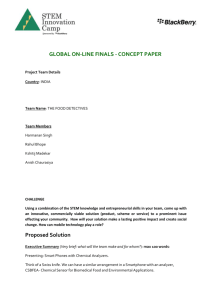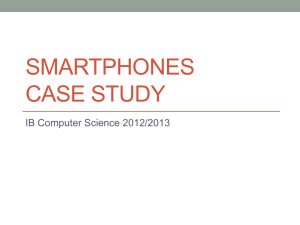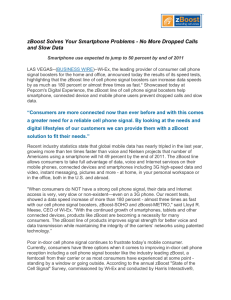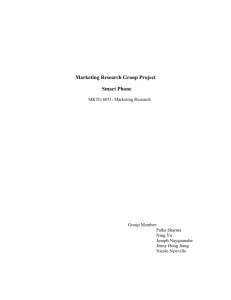scm_c4p4_supply chain process framework_paper
advertisement
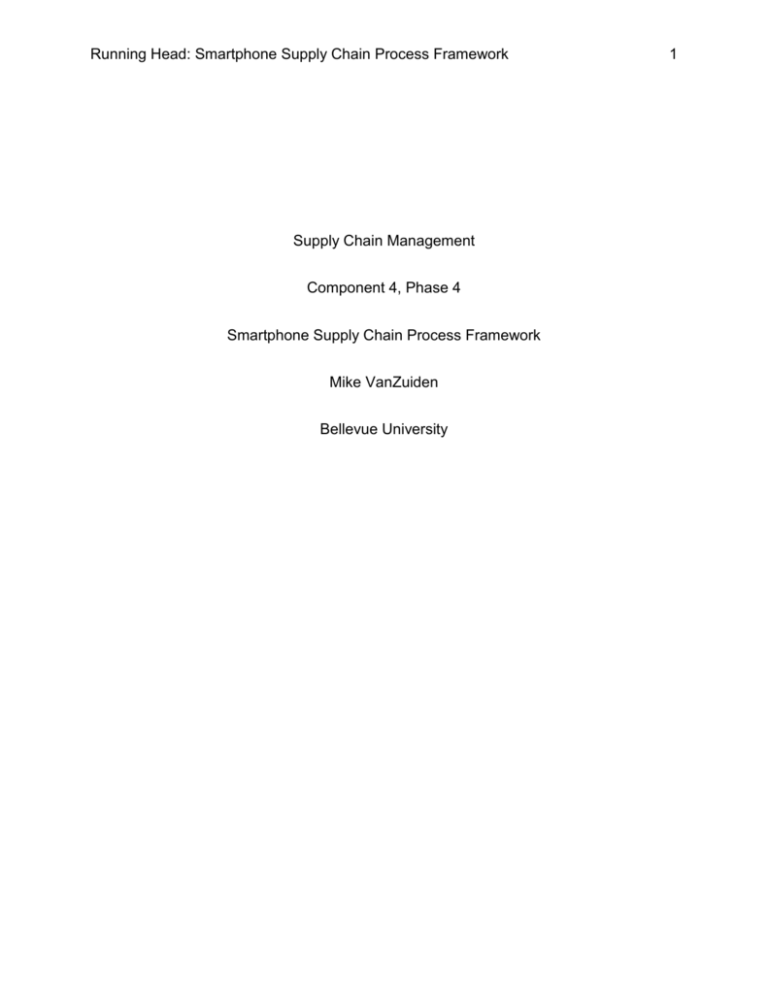
Running Head: Smartphone Supply Chain Process Framework Supply Chain Management Component 4, Phase 4 Smartphone Supply Chain Process Framework Mike VanZuiden Bellevue University 1 Smartphone Supply Chain Framework 2 Abstract Once owned completely by a few electronics/communication giants, startup smartphone manufacturers are beginning to proliferate. This is due to the mass availability of many of the industry standard components, parts and software (Culpin, 2013). With this in mind, Bob Trumped has decided to start his own international smartphone company. The focus of the owner/investor is to build a brand that represents social and environmental responsibility while maintaining low costs and superior customer service. The plan is to accomplish this through an agile hybrid supply chain model that includes some centralized component assembly to facilitate a fast response from decentralized, regional assembly facilities that are adaptable to customer demands and technology shifts. Products will drop ship to a network of retailers. Supply chain alignment will be maintained using KPI’s fueled by strong ERP system that is driven by RFID and demographic feedback. Metrics and strategy will be used to address opportunities that are shared and rolled up from a network of stakeholders at the department, region, state and international levels. Corporate values for all supply chain members will be managed and monitored through a centralized audit system supported by corporate and supplier codes of conduct. Smartphone Supply Chain Framework 3 Body There is a smartphone explosion happening in the smartphone industry and a good friend of mine wants to join the fray. Seeing that more companies are supporting a bring-your-own phone platform; my friend, who is a self-made multimillionaire named Bob Trumped, is sure that there is a way to build these devices for less and cash in on significant margins, so he is determined to create a new smartphone brand called Fictiphone. Having taken a course in supply chain management, my friend Bob has called on me to assist him in creating a supply chain framework that would be adequate to accommodate customers in the U.S., Canada, Mexico, France, Germany and Australia with the service they had become accustomed to in terms of speed and quality, but at a lower price. Additionally, Bob only does business with companies who are environmentally and socially responsible; he has said that he wants his company to represent these same values. Fictiphone will need to find an advantage if they are to build a less expensive product while meeting the responsibility, quality and delivery expectations of the customer and Bob, taking an “intersectionist” (Larson; Poist; Halldorsson, 2007) approach to business design, was wise to instigate the supply chain in the search for answers. Beginning our research with raw materials, we were able to find out a few things that are important to creating a sustainable supply chain. First, most smartphones are built from 62 different materials; this includes everything from the outer shell to the electronics. Unfortunately, of those 62 materials, there are some potential Smartphone Supply Chain Framework 4 problems; some of these materials are in short supply, none have substitutes that perform equally well, and 12 of the materials have no substitute at all. To complicate things further, some of the metals that are used in every smartphone are without substitute and in short supply. Additionally these rare metals are found only in the countries of South Africa and the Congo, countries that face near constant political turmoil. All of these issues work together to make smartphone supply chain stability and challenge (Greenquist, 2013). In terms of the supply chain framework, the market has two giants that together control more than 50% of the overall smartphone market and each of them takes a different approach to manufacturing. Samsung, the number one smartphone producer, has chosen to use a model where they own most of their supply chain, only outsourcing where parts/components are commoditized and readily available from other sources. This gives the company the ability to leverage their buying power. Additionally the company has manufacturing facilities around the world to match supply to demand regionally and therefore can offer many product variations so as to appeal to the largest customer demographic. It is also worth noting that Samsung is known for paying its employees well above the industry average while still making significant margins (Gharbijanian, 2014). The second largest manufacturer, Apple, takes almost the opposite approach. They outsource most of their manufacturing and supply chain activities. Apple limits their product options to consumers so as to increase the volume of each item. When combined with their high product loyalty Apple is able to focus less on the product itself and more on managing their vendors. However, to facilitate effective management, Smartphone Supply Chain Framework 5 Apple chooses to work almost exclusively with Asian companies having over 80% of their production contracts there (Gharbijanian, 2014). This makes the company more susceptible to higher warehousing and transportation costs and may leave them at some political risk. Another consideration that is important to the process is the location of the headquarters. Bob likes living on the west coast of the U.S. and would like to keep his corporate headquarters close to home. The company will plan to launch with their headquarters in the U.S. as Bob wishes. Understanding these things about the supply chain allows Fictiphone to begin its supply chain design. Based on what has been learned, Bob has decided he would like to hire a team of HR professionals and lawyers to develop his corporate and supplier codes of conduct. These code documents will define Bob’s vision regarding corporate and subordinate environmental and socially responsibility and set the standard for all to work under. It will be important for Fictiphone to understand how their operations will align with the people, cultures and laws of each country, state and region. An extension of the legal and HR teams should begin work in all of the countries where the company will operate; an effort that should engage local contacts. This includes not only where the smartphones will be distributed, but where factories will be located and where parts and materials will be sourced. Bob and his financial team have decided that it is not in the best interest of the company to own the entire supply chain at this point, so the model that The Fictiphone Smartphone Supply Chain Framework 6 supply chain will begin with will be a hybrid approach. They plan to own a central component design/assembly factory that will ship parts to regional assembly/distribution centers located around the world. This framework should allow Fictiphone to be highly responsive to customization and demand from local retailers, require little warehouse as product will be drop shipped to retailers (Entrepreneur, n.d.). Overall this design, when coupled with well-designed information/ordering systems, should help to reduce the bullwhip effect and create a cost effective supply chain. A strong supply chain begins with a viable supplier of raw materials and ends with a comprehensive and satisfactory customer service and return process. Although the company is twice removed from raw materials supply, Fictaphone will want to make sure that their parts suppliers have access to all of the raw materials that they will need to fulfill Fictiphone’s demand for parts and that they are all supplied from companies that represent Fictiphone’s corporate values. These relationships will be audited and maintained through contracts and contract management by Fictiphone. In order to hold down costs, Fictiphone’s engineering team believes that they have improved on production methods for some of the key assemblies that will be used in their phone. They have begun work with parts manufacturers to design and produce these parts. A second key to lower costs is to use as many common commodity parts as possible in their overall design. This will allow Fictiphone the option to source these parts locally, supporting local businesses and communities while minimizing shipping costs, or leveraging international and volume buying power where appropriate. Smartphone Supply Chain Framework 7 Planning is an important part of an efficient and effective supply chain. To facilitate the flow of information that will drive the planning and forecasting functions, Fictiphone will rely on an ERP system that is driven by RFID and demographic feedback systems that will encompass and inform the entire supply chain process. These areas include and will aid in customer relationship management, customer service management, demand management, order fulfillment, manufacturing flow management, procurement, product development and returns (Croxton; Garcis-Dastugue; lambert; Rogers, 2001). The data gleaned from these systems and processes will lead to other advantages for the company. This is another area where Fictiphone can develop a cost advantage over its competitors. For example, employees in Fictiphone’s Customer Contact Centers will have access to information and guided access to insights that will allow them to assist customers with issues and concerns; information that could include component availability and deliveries and impending product improvements will help them to exceed customers expectations By empowering employees to assist customers in this fashion, Fictiphone will be able to launch an aggressive web based interface that will facilitate custom smartphone orders for pickup or delivery locally, pre-set up to each customer’s preferences; while allowing the traditional packaged phone available for the typical user. In addition to making information available for near real time use, Fictiphone will also create forums to discuss insights gleaned from systems. These forums would include all of Fictiphone’s supply chain stakeholders from the raw material suppliers to consumers and other advocates/stakeholders. The forums would occur in Smartphone Supply Chain Framework interdepartmental, reginal, national and international events so as to represent, rollup and create a plan to address the opportunities presented by each group (Croxton; Garcis-Dastugue; lambert; Rogers, 2001). Data would be used to support and align thoughts and opportunities with processes so as to facilitate leadership support and empowerment to foster a culture of continuous improvement and lean processes (Martin, n.d.). To measure performance and improvement, the data stream can facilitate a number of key metrics. These may include, but are not limited to, metrics such as production costs per smartphone, ROA, inventory turnover, back order rate and perfect order rate (Klipfolio, n.d.). Key metrics should be focused on critical areas of performance that leadership wishes to improve and may change over time. Setting the correct metric targets with all stakeholders involved is another level of assurance that Fictiphone’s supply chain will be aligned to achieve its low cost, objective while maintaining exemplary customer service. In summary, by taking advantage of things such as Google’s free Android operating system in addition to standardized chips and technology, there is an opportunity in the market to grab a share of what Samsung and Apple own today (Culpin, 2015). By leveraging an umbrella approach to supply chain management that is agile, adaptable, aligned; and in attentive to the flow of data from its systems, Fictiphone should have the tools necessary to build a low cost alternative without sacrificing quality, service or delivery speed. 8 Smartphone Supply Chain Framework 9 Fictiphone plans to leverage minimal proprietary parts to take advantage of the market, but intends to pre-assemble some key subcomponents at a central facility. These components will be shipped to regional assembly hubs where they will be combined with other commoditized parts purchased locally wherever possible to minimize shipping/warehousing costs and support local businesses. From here, Fictiphones will be drop shipped on demand to retailers for pickup and activation. This will facilitate responsive supply, allow for customer specific customization/set-up and the ability to quickly adapt to changing technologies. Sustainability and corporate responsibility is insured through end-to-end code of conduct commitments from all vendors and employees. These take into consideration the unique requirements of each region while ensuring corporate, social and environmental responsibility. Materials, parts and supplies will be managed along with compliance efforts. All processes, products and transactions will be tracked and measured using KPI’s developed by stakeholders and strategies will be guided by metric targets. This data and resulting information will be available to all stakeholders near real time to keep the targets in focus. Now ready to launch his new business, Bob has asked for a standardized map to assist with development, training and communication of the Fictiphone supply chain approach. A SCOR process model (Supply Chain Council, 2006) has been developed as requested to guide current business development and sustain process integrity (see below). Smartphone Supply Chain Framework 10 Smartphone Supply Chain Framework 11 References Croxton, Keely L.; Garcia-Dastugue, Sebastian J.; Lambert, Douglas M.; Rogers, Dale S.. (2001). The supply chain management process. International Journal of Logistics Management. Retrieved from http://search.proquest.com.ezproxy.bellevue.edu/docview/235873785?accountID 28215 Culpin, Tim. (7/13/2015). Start Your Own Smartphone Company for $1,000. Bloomberg Business. Retrieved from http://www.bloomberg.com/news/articles/2015-07-13/how-1-000-buys-asmartphone-brand-to-challenge-samsung Entrepreneur Staff. (n.d.). Drop Shipping. Entreprenueur.com. Retrieved from http://www.entrepreneur.com/encyclopedia/drop-shipping Gharbijanian, Varag. (4/2013). Billions Served (In Secret): How their mobile supply chaines give Apple and Samsung an edge. Endeavour Partners. Retrieved from http://endeavourpartners.net/billions-served-in-secret-how-their-mobile-supplychains-give-apple-and-samsung-an-edge/ Greenquist, Brittany. (2013). Raw Smartphone Materials Could Be Running Out – and No One Has a Solution. RYOT. Retrieved from http://www.ryot.org/rawsmartphone-materials-could-be-running-out-no-one-has-solution/491801 Smartphone Supply Chain Framework 12 Klipfolio. (n.d.). Supply Chain Metrics and KPI Examples. Retrieved from http://www.klipfolio.com/resources/kpi-examples/supply-chain Larson, Paul D.; Poist, Richard F.; Halldorsson, Arni. (2007). Perspectives On Logistics vs. SCM: A Survey of SCM Professionals. Journal of Business Logistics. Retrieved from http://search.proquest.com.ezproxy.bellevue.edu/docview/212652114/BD63D286 3F2E4FA1PQ/1?accountid=28125 Martin, James W.. (n.d.). Making SCOR Model More Effective with Lean Six Sigma. iSixSigma. Retrieved from http://www.isixsigma.com/operations/supplychain/making-scor-model-more-effective-lean-six-sigma/ Supply Chain Council. (2006). Supply-Chain Operations Reference-model. Retrieved from http://people.ischool.berkeley.edu/~glushko/IS243Readings/SCORV8.pdf

